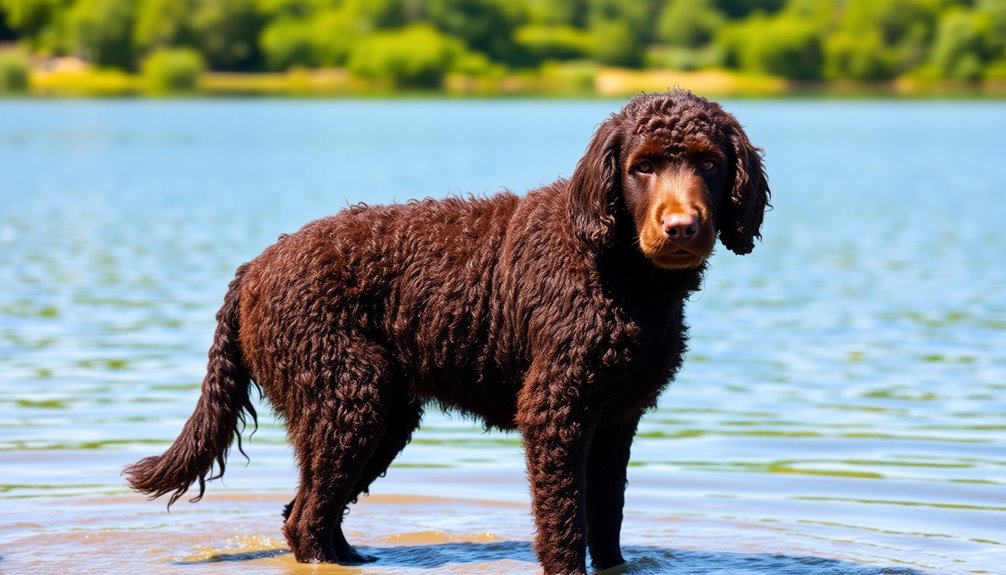The Irish Water Spaniel's an exceptional breed known for its playful spirit and love for water. With a unique curly coat and athletic build, it's designed for active families who enjoy outdoor adventures. This breed thrives on companionship and needs 1-2 hours of exercise daily, making swimming and interactive play perfect activities. Their intelligence makes them easily trainable, while their gentle nature fosters strong family bonds. Although generally healthy, they may face specific health issues, so proper care is essential. You'll soon discover even more about this versatile and charming breed!
Key Takeaways
- The Irish Water Spaniel has a unique, curly waterproof coat that makes it well-suited for aquatic environments.
- Originating in 17th century Ireland, they excel as water retrievers and hunting companions.
- Their playful and intelligent nature allows them to bond closely with families, making them excellent companions.
- This breed requires 1-2 hours of vigorous exercise daily, thriving in active lifestyles and water activities.
- Regular grooming is essential to maintain their coat health and prevent matting, ensuring overall well-being.
Introduction
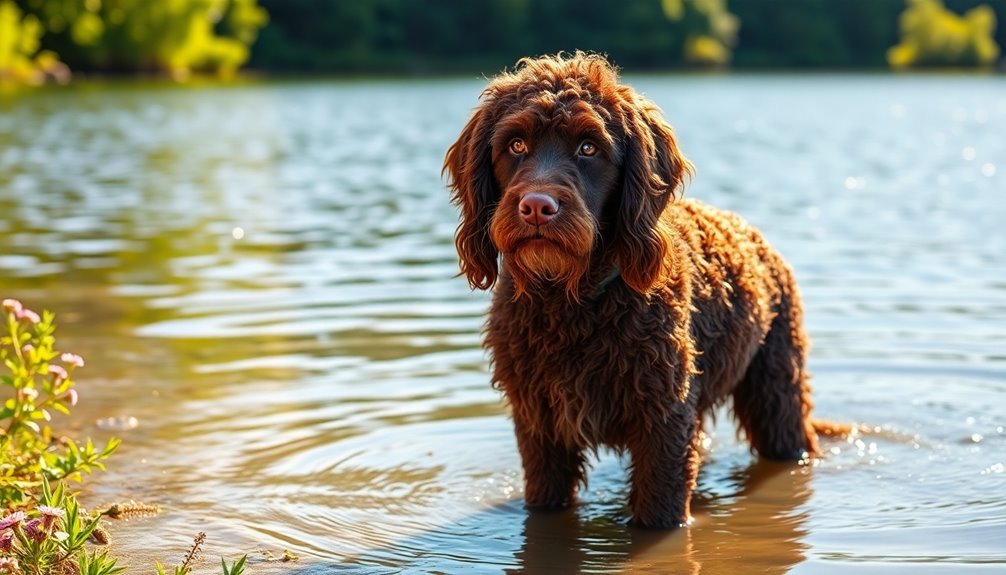
When you think of unique dog breeds, the Irish Water Spaniel stands out with its distinctive appearance and spirited personality. This breed typically measures between 22 to 24 inches tall and weighs 55 to 65 pounds, showcasing a ruggedly built, athletic body.
Its dense, curly coat is waterproof and comes in shades of liver-puce to chocolate-brown, often with a striking purple undertone. You'll notice the charming topknot of long curls that can cover its eyes, along with a beard and sideburns that add to its character.
The Irish Water Spaniel isn't just a pretty face; it's highly intelligent and eager to please, making training relatively easy. With a playful, high-energy temperament, it thrives in active households and requires regular exercise to stay happy. Additionally, their natural swimming ability allows them to excel in water-related activities, further showcasing their versatility.
Their natural swimming ability, thanks to webbed feet, makes them ideal companions for water activities. While affectionate and loving, they can also be alert and sensitive to their surroundings.
Early socialization is essential to help them interact well with children and other pets. Overall, the Irish Water Spaniel is a versatile, engaging breed that can bring joy to any family.
History and Origin
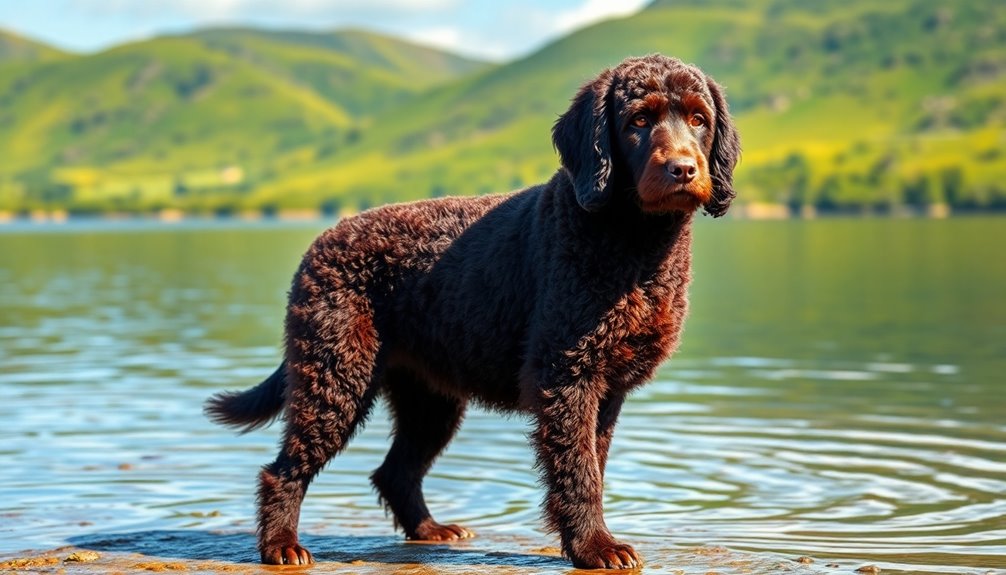
The Irish Water Spaniel traces its roots back to 17th century Ireland, particularly around the River Shannon.
This breed emerged as a skilled water retriever and hunting companion, developed from various local water-efficient dogs.
Its unique blend of ancestry and purposeful breeding makes it one of the oldest water spaniels still recognized today. The breed is believed to have developed from South Country and North Country Water Spaniels prior to the 1850s.
Where and when the breed originated
Originating in Ireland, the Irish Water Spaniel boasts a rich history that traces back to the division of spaniels into land and water varieties centuries ago. This breed developed from two distinct strains: the South Country Water Spaniel and the North Country Water Spaniel. The Southern Ireland variety closely resembles what you see as the modern Irish Water Spaniel today.
Notably, the breed was refined in Dublin, where it gained recognition and various nicknames, including Shannon Spaniels, Rat Tail Spaniels, Whiptail Spaniels, and Bog Dogs.
The breed's roots can be traced back as far as the 7th century, suggesting a lineage that includes potential ancestors like the Poodle, Barbet, and Portuguese Water Dog. You can find the first mention of the Irish Water Spaniel in the 1607 book "Historie of the Foure-tooted Beastes." Additionally, the breed was developed in the 1830s as a result of the efforts of Justin McCarthy and his dog, Boatswain, which helped solidify its hunting capabilities.
Water Retrieval and Hunting
With a lineage steeped in water retrieval and hunting, the Irish Water Spaniel has developed remarkable skills that make it a standout among gundogs. Descended from various water spaniels, including the now-extinct Tweed Water Spaniel, this breed was refined in the 1830s by Justin McCarthy in Dublin, focusing on enhancing these attributes. His dog, "Boatswain," played a crucial role in defining the modern Irish Water Spaniel.
This breed combines the hunting prowess of spaniels with the retrieving capabilities of water dogs. Known for their methodical hunting techniques, Irish Water Spaniels use their excellent noses to work fields effectively, responding to wind direction to flush birds. Their stiffly vibrating tails signal when they're ready to spring into action. These dogs demonstrate a unique ability to thrive in various environments due to their water-resistant coats.
These dogs autonomously navigate terrain and understand bird behavior, ensuring they remain within gunning range. In cold waters, they shine, displaying remarkable hardiness and a strong work ethic, essential for water retrieves.
Training should focus on motivation through toys and praise, allowing them to gain confidence and improve field performance, earning titles like Junior Hunter in AKC tests. Ultimately, their versatility makes them invaluable companions in both upland and water hunting scenarios.
Physical Characteristics
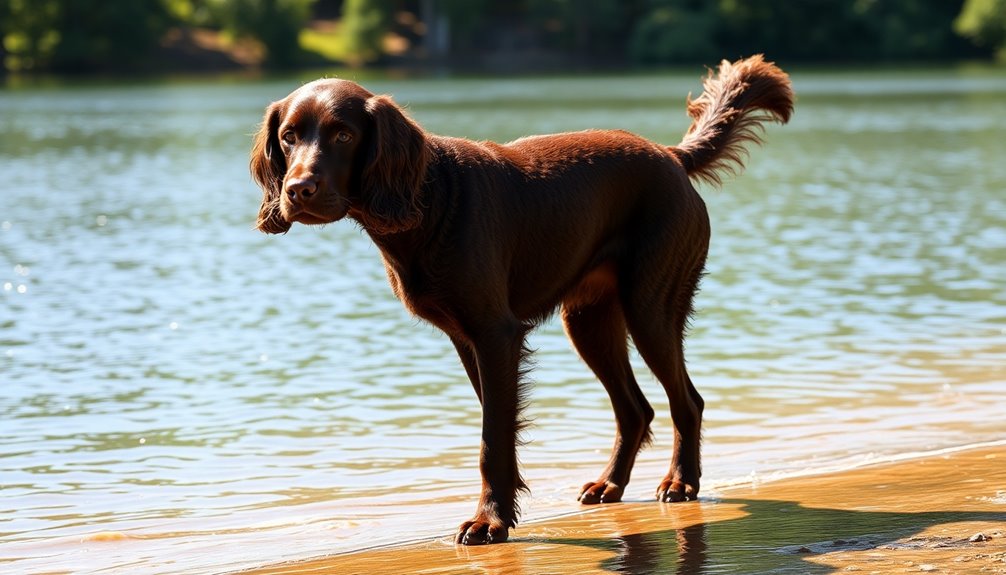
When you look at an Irish Water Spaniel, you'll notice its medium to large size, standing between 21 to 24 inches tall.
Weighing between 45 to 68 pounds, these dogs are known for their athletic build and powerful shoulders.
Their distinctive curly, water-resistant coat not only adds to their unique appearance but also helps them thrive in wet conditions.
This breed's webbed feet are an additional adaptation that enhances their swimming abilities.
Size, weight, and coat details
The Irish Water Spaniel is a medium to large dog, standing between 21 to 24 inches tall. Both males and females fall within this height range, showcasing a solidly built yet agile physique.
Weighing between 45 to 68 pounds, males typically range from 55 to 68 pounds, while females weigh between 45 to 58 pounds. The average weight for this breed generally hovers around 55 to 65 pounds.
With a strong and muscular build, the Irish Water Spaniel exudes an upstanding appearance. You'll notice it's not leggy; instead, it has a sturdy frame that supports its active lifestyle. The dog's webbed feet are perfect for swimming, enhancing its natural ability in the water. This breed is known for its excellent swimming abilities, which further underscores its affinity for aquatic environments.
Distinguishing features include a smooth "rat tail" that tapers and is covered in tight curls at the base. The face, including the muzzle and lower jaw, is entirely smooth, complementing the trademark topknot of curls on its head.
The throat and neck display smooth hair, accented by a V-shaped patch. Additionally, the smooth hair on the hind legs below the hocks rounds out this breed's unique physical characteristics.
Curly, Water-Resistant Coat
At first glance, you'll notice the Irish Water Spaniel's unique curly coat, which not only enhances its appearance but also serves a functional purpose. This breed boasts a rich liver color with a purplish tinge, called puce liver, and features a distinctive topknot of long, loose curls on its head.
The body is covered in dense, tighter curls that are both water-repellent and insulating, keeping your dog warm during cold weather. Additionally, their water-repellent coat and webbed feet make them particularly adept at swimming. This breed's unique coat requires regular grooming to maintain its health and appearance.
To maintain this striking coat, you'll need to commit to regular grooming. Brush your dog's coat a few times a week with a pin or slicker brush to prevent matting and tangling. Bathing should occur every two to three months using high-quality dog shampoo, ensuring you rinse thoroughly to avoid residue.
Every couple of months, you'll also need to clip the coat to maintain its unique appearance, which may require professional grooming due to its complexity.
Regular care not only enhances your dog's appearance but also contributes to its overall health. Don't forget to clean the ears and trim the nails regularly to keep your Irish Water Spaniel happy and healthy.
Temperament and Personality
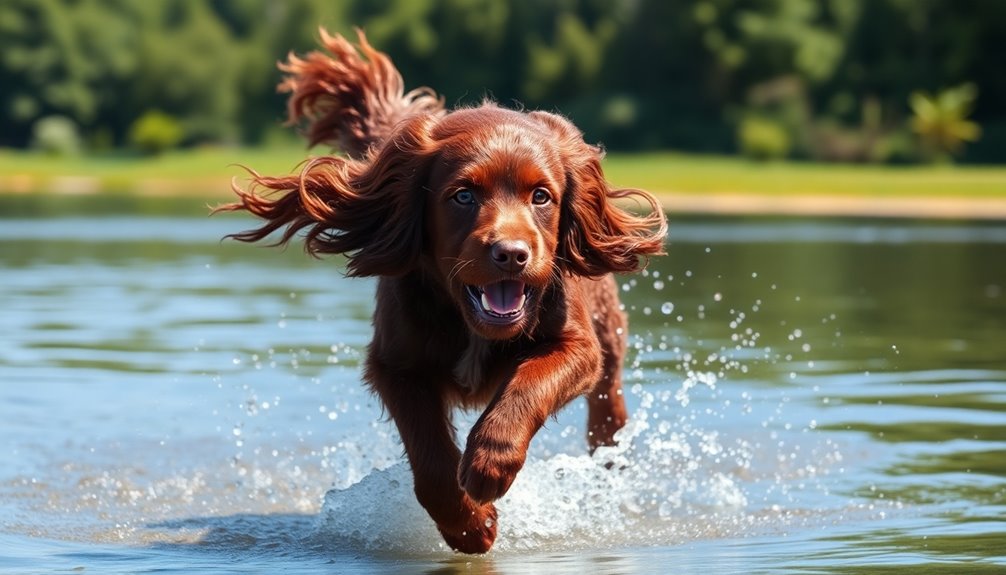
The Irish Water Spaniel is an incredibly playful and intelligent breed that brings joy to any household. They thrive in family environments, showing affection and loyalty while also needing proper socialization with other pets. With the right training and interactions, they can be wonderful companions for both individuals and families alike. Additionally, they require vigorous exercise to keep them mentally stimulated and prevent boredom.
Playful and Intelligent Nature
Irish Water Spaniels are known for their playful and intelligent nature, making them a delightful addition to any active household.
You'll find they require substantial exercise, needing at least 1 to 2 hours daily. They thrive on physical activities like brisk walks, swimming, and interactive play sessions, so be prepared for an energetic companion. Engaging them in retrieving games or scent work will tap into their natural instincts, keeping them mentally stimulated. These dogs are recognized for their impressive swimming ability, which makes water activities particularly enjoyable for them.
These dogs are highly intelligent and eager to please. They respond best to positive reinforcement, so using praise, treats, and play as motivators during training sessions is crucial.
Keep training engaging, varied, and short to prevent boredom, and remember that consistency and patience are key. While they can be independent thinkers, confident training will help them shine.
Affectionate and social, Irish Water Spaniels form strong bonds with their families. They prefer human companionship, so regular interaction is essential.
You'll notice their unique "quizzical" nature as they often do ordinary things in extraordinary ways. Just be aware that they can be a bit stubborn at times, especially during the initial stages of training.
Suitability for families, individuals, or other pets
Many families find Irish Water Spaniels to be excellent companions due to their gentle and easygoing nature. These dogs typically bond closely with their families and thrive on inclusion in family activities like road trips and camping. As high-energy dogs that require significant mental and physical stimulation, they benefit from regular outdoor activities with their families.
However, they don't do well when left alone for extended periods, so it's important to ensure they've company.
Irish Water Spaniels generally get along well with children when properly trained and socialized. They can be enthusiastic, so supervision is key, especially around younger kids. Teaching children to interact respectfully—avoiding their face, paws, or tail—fosters a harmonious environment.
When it comes to other pets, these spaniels can coexist peacefully with dogs if introduced gradually. They may require more caution around cats or smaller animals due to their hunting instincts. Initial interactions should always be supervised, as some may take longer to adjust or never fully accept smaller pets.
While they can be shy with strangers, proper socialization helps them feel comfortable. Once they establish a bond with family members, their loyalty shines through, making them protective and devoted companions.
Health and Lifespan
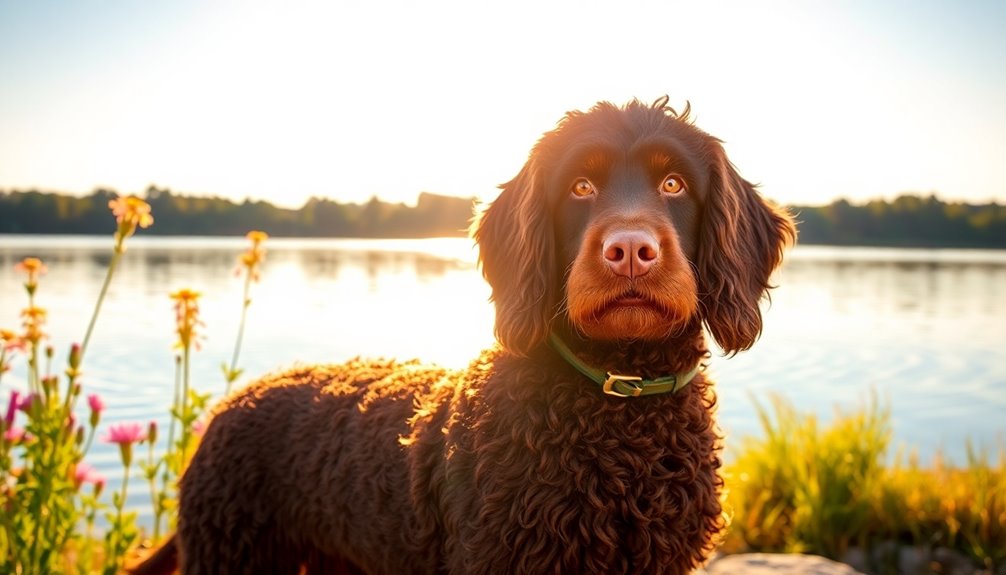
When it comes to the health and lifespan of the Irish Water Spaniel, you should know that they typically live between 12 to 13 years. This breed is generally healthy, but they can be prone to certain genetic conditions like hip dysplasia and hypothyroidism. To keep your pup thriving, regular vet check-ups and a balanced diet are essential. Additionally, their active lifestyle plays a significant role in preventing health issues and promoting overall well-being.
Typical lifespan of the breed
Longevity is an essential aspect to consider for anyone thinking about welcoming an Irish Water Spaniel into their home. This breed typically lives between 12 to 15 years, with an average lifespan of around 12 to 13 years. Various factors can influence their longevity, including genetics, diet, exercise, environment, and the quality of veterinary care you provide.
Irish Water Spaniels are generally healthy, but their well-being heavily relies on proper care. Regular veterinary check-ups, a balanced diet, and an active lifestyle contribute significantly to their overall health and longevity. Additionally, maintaining their health is vital as they can be prone to specific conditions such as hip dysplasia.
An active lifestyle is crucial; it not only keeps them happy but also helps prevent potential health issues down the line.
These dogs thrive when living indoors as part of the family, enjoying regular interaction and mental stimulation. Their medium-to-large size, along with their dense curly coat, requires consistent grooming and attention to ear health.
Common health concerns or genetic predispositions
Irish Water Spaniels are prone to several common health concerns and genetic predispositions that potential owners should be aware of. One of the most significant issues is hip and elbow dysplasia, which are hereditary conditions that can lead to joint problems.
You should also keep an eye out for eye issues, such as distichiasis, where ingrown eyelashes cause discomfort. Autoimmune hypothyroidism is another genetic concern, along with immune deficiencies.
Additionally, be cautious about drug sensitivities. Many Irish Water Spaniels react poorly to sulfa drugs and ivermectin, commonly found in heartworm preventatives. They can also have reactions to certain flea and tick medications, so it's crucial to inform your vet about these sensitivities. Participation in the CHIC program promotes responsible breeding practices, which can help reduce the prevalence of these health issues.
Other specific health conditions include seizures, cancer, and frequent ear infections due to their love for water. Regular cardiac health monitoring is also important.
To minimize risks, consult with breeders who participate in health testing programs like the Canine Health Information Center (CHIC) and ensure both parents have good health scores. This proactive approach will help you maintain your Irish Water Spaniel's health and longevity.
Tips for maintaining health and wellness
Maintaining your Irish Water Spaniel's health and wellness requires a proactive approach that encompasses regular veterinary care, exercise, proper nutrition, and grooming.
Schedule routine check-ups with your vet to ensure vaccinations are up-to-date and to catch any health issues early. Dental care is equally important, so keep an eye on your dog's teeth during these visits.
Your Irish Water Spaniel needs at least 1-2 hours of vigorous exercise daily. Engage in activities like walking, hiking, swimming, or playing fetch to keep them physically fit and mentally stimulated. Daily exercise is essential to prevent boredom-related issues and maintain their overall well-being.
Interactive sessions, such as agility courses or tug-of-war, can also be beneficial.
Nutrition plays a crucial role in their overall health. Feed high-quality dog food formulated for active breeds, and consult your veterinarian for the best diet plan tailored to your dog's age, weight, and activity level.
Serve two measured meals a day and always provide fresh water.
Grooming is essential too. Brush your dog's curly coat at least once a week to prevent mats, and bathe them every 4-6 weeks.
Regular ear cleaning can prevent infections, and ensure your home is safe and comfortable for your furry friend.
Care Requirements
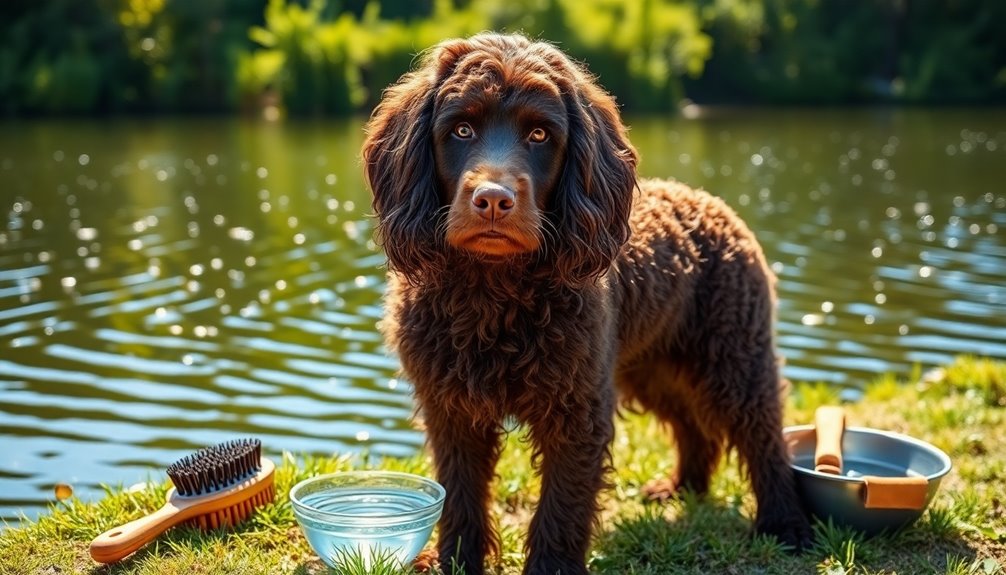
Caring for your Irish Water Spaniel means staying on top of their grooming needs, including regular trimming to keep their unique coat healthy. Regularly trimming sunburned or frizzy ends is important for maintaining a sleek appearance. You'll also need to ensure they get plenty of exercise each day to match their energy levels. Finally, pay attention to their diet, as a balanced feeding plan is essential for maintaining their overall health.
Regular Trimming Required
Regular trimming is essential for keeping your Irish Water Spaniel looking its best and maintaining its unique coat structure. You'll need to trim your dog every two to three months to prevent excessive hair growth and keep the coat in optimal condition.
While you can groom at home, professional services are often recommended due to the complexity of the breed's specific clip. To achieve the desired appearance, focus on areas like the topknot, neck, and tail. Use a slicker brush or pin brush to detangle the curls and remove loose hair during regular brushing.
When it's time for trimming, make sure to follow the breed standard. Scissors and clippers will be necessary for shaping. Pay special attention to the topknot, ensuring long, loose curls are neatly shaped. Additionally, regular brushing helps distribute natural oils throughout the coat, which contributes to a shiny, healthy appearance.
The neck should be clipped to about two inches, while the back and croup should be around one inch. The brisket coat should extend to the elbow, and the area in front of the tail needs to be rounded. If you're ever uncertain, don't hesitate to consult a professional to keep your spaniel's coat healthy and beautiful.
Exercise requirements and energy levels
An Irish Water Spaniel is an energetic breed that requires at least 1 to 2 hours of exercise each day to stay healthy and happy. To meet their needs, ensure they get a mix of brisk walks, jogging, and interactive play sessions.
Daily physical activity not only helps keep them physically fit but also mentally stimulated, which is crucial for their overall well-being. Regular exercise can also help mitigate the risk of obesity, which poses various health risks for the breed.
Incorporate activities that tap into their natural instincts, like fetch and tug-of-war. Swimming is particularly beneficial due to their love for water. You might also consider dog sports like obedience, rally, or agility to challenge them further.
For young puppies, keep exercise short and controlled to avoid strain on their developing joints. Moderate walks and play sessions can gradually increase in intensity as they grow.
Always consult your veterinarian for specific guidelines tailored to your puppy's age and individual needs.
Creating opportunities for your Irish Water Spaniel to explore new environments and interact with other dogs is essential. A spacious fenced backyard or access to dog parks can help fulfill their exercise requirements, making them happier and healthier companions.
Feeding tips and diet recommendations
Feeding your Irish Water Spaniel a well-balanced diet is crucial for their health and vitality. Start with high-quality protein sources like beef, chicken, turkey, lamb, or fish to support muscle maintenance and energy levels. These proteins are essential for growth and muscle repair, impacting all body functions. Irish Water Spaniels are known for their excellent swimmers, making their energy needs particularly high. Additionally, providing a diet rich in veterinary care can enhance their overall well-being.
Incorporate healthy fats, such as omega-3 and omega-6 fatty acids, which are vital for coat, skin, and brain health. Sources like fish oil and flaxseed are excellent additions. Pair these with complex carbohydrates like sweet potatoes, brown rice, or oats for steady energy, avoiding simple carbs that can lead to energy spikes.
Always provide fresh, clean water, especially after exercise. To keep meals exciting, consider mixing wet food with dry kibble. For adult dogs, feed two measured meals per day, while puppies require 3-4 meals until six months old.
Ensure a balanced diet tailored to their life stage and energy needs, including fiber from vegetables and whole grains for digestion. Avoid common allergens and artificial additives.
Regularly assess their weight and adjust the feeding quantities as necessary to maintain optimal health.
Training and Socialization
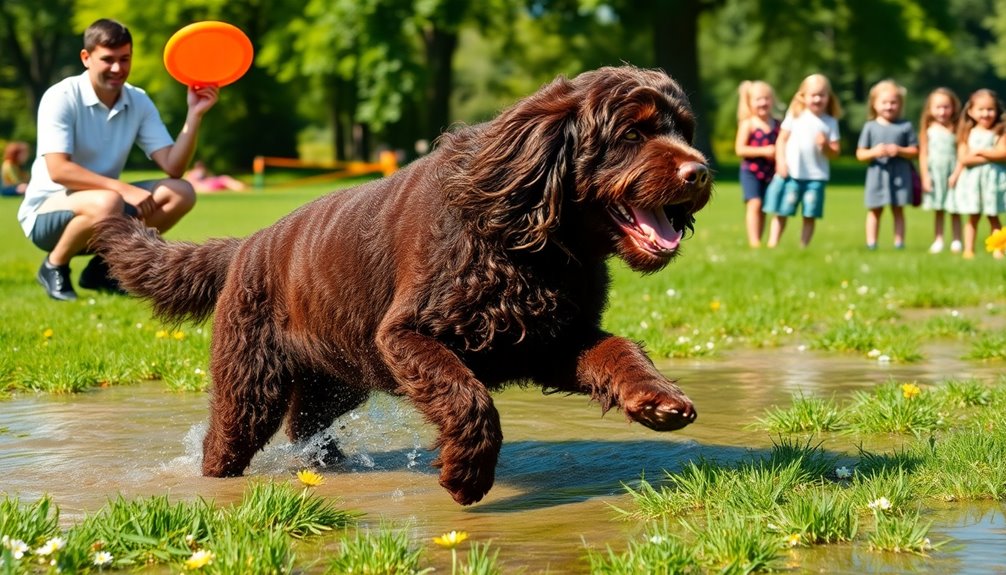
Training your Irish Water Spaniel can be moderately challenging, so it's essential to stay patient and consistent. Gradually introducing them to new environments helps build their confidence, which is crucial for their development. Keep in mind that they might experience separation anxiety in unfamiliar settings, so gentle acclimatization is key. Regular exercise is also vital for managing their high energy levels, ensuring they remain well-rounded and content.
Moderately Challenging to Train
Irish Water Spaniels can be moderately challenging to train due to their intelligence and occasionally stubborn nature. To effectively train your dog, rely on positive reinforcement techniques. Using treats, praise, or playtime as rewards for desired behaviors will encourage your pup to learn.
Consistency is crucial; establish clear rules to avoid confusion and ensure your dog understands what's expected. Ignore unwanted behaviors while focusing on rewarding the good ones. Incorporate motivational methods like toys and food to keep your dog engaged. Additionally, it's important to be aware that early socialization is critical for preventing behavioral issues, making it easier to train your dog.
Remember, heavy-handed corrections aren't suitable for this breed—they can lead to fear or resistance, hindering progress. Keep training sessions short and engaging, around 5-10 minutes, to maintain your dog's attention.
Start training as soon as you bring your Irish Water Spaniel home, using clear and consistent commands to facilitate quick learning. Building a strong bond through positive reinforcement will help manage their independent tendencies.
Early socialization, exposing your dog to various people, environments, and other animals, is also essential. This exposure prevents behavioral issues and promotes confidence, making training easier in the long run.
With patience and the right approach, you'll enjoy the rewarding experience of training your Irish Water Spaniel.
Gradual Introductions to New Environments
Introducing your Irish Water Spaniel to new environments gradually is key to ensuring they adapt well and feel secure. Start by exposing your puppy to different settings early on, as this helps them build confidence and adaptability. During their critical fear periods, between 8-13 weeks and 8-15 months, provide positive experiences to foster healthy development. Your breeder can offer specific socialization guidelines to aid you.
When introducing your pup to a new household, keep things calm. Begin with confined spaces before gradually expanding their territory. Establish consistent daily routines to help them feel relaxed and secure. Initially, introduce new dogs on neutral ground and avoid overwhelming them with too many pets at once.
Engaging in interactive activities, like brisk walks, swimming, or retrieving, can help your Irish Water Spaniel acclimate to new environments. Use positive reinforcement, like treats and praise, to encourage good behavior. This approach not only fosters a strong bond but also teaches your dog essential commands. Additionally, regular exercise is essential for maintaining their energy levels, which contributes to a well-adjusted and happy pet.
Separation Anxiety in New Settings
When your Irish Water Spaniel faces a new environment, separation anxiety can become a significant concern. These dogs form strong attachments to their human family members, making them vulnerable to anxiety when left alone. You might notice anxious behaviors like pacing, whining, or excessive barking, especially during your departure. Destructive chewing or attempts to escape can also signal their distress. To mitigate this, early obedience and socialization training are essential. Start by exposing your Spaniel to various settings and experiences, ensuring they feel confident in new situations. Consistency is key—establish clear rules and routines to avoid confusion. Use positive reinforcement techniques, rewarding them with treats or praise when they remain calm during your absence. Additionally, affectionate companion breeds like the Irish Water Spaniel benefit greatly from socialization, helping them adapt to different environments.
It is also beneficial to consult pediatric sleep specialists if your dog exhibits severe anxiety, as they can provide tailored strategies for managing stress. Additionally, consider their exercise needs. A well-exercised dog is less likely to develop anxiety issues. Incorporate daily physical activities and mental stimulation, which can help reduce restlessness and improve their overall behavior.
Ideal Living Environment
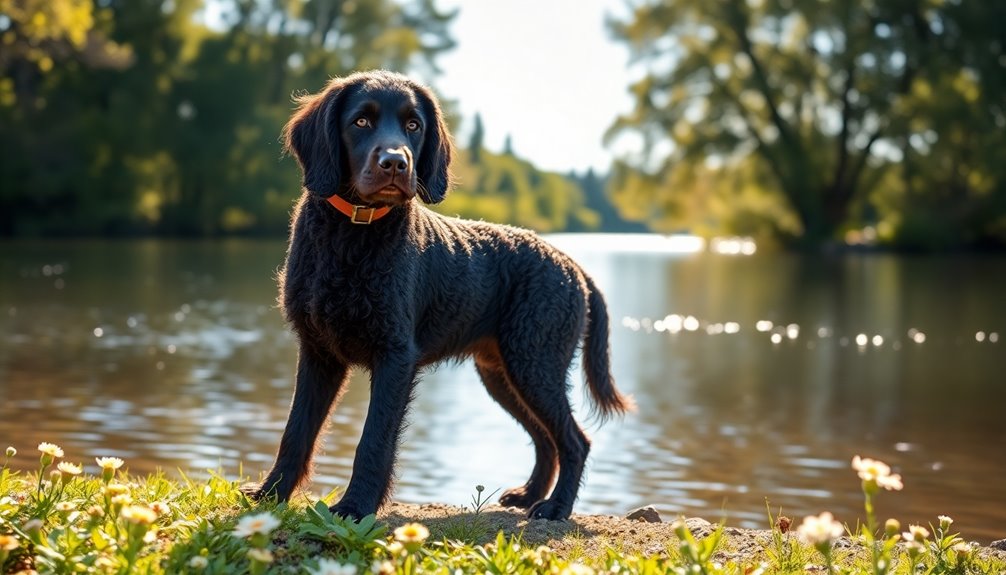
To keep your Irish Water Spaniel happy, you'll want a spacious home with easy access to water for swimming and play. They thrive in cool, humid climates, so consider your local weather when planning their living environment. Providing plenty of room to explore and stay active will ensure your pup remains healthy and content. Additionally, this breed requires substantial daily exercise to maintain optimal health and prevent boredom. Incorporating proper ventilation in their living space can also enhance comfort and overall well-being.
Spacious Homes With Water Access
For the Irish Water Spaniel, a spacious home with easy access to water is more than a luxury—it's a necessity. This breed thrives in environments where they can roam freely, so a securely fenced yard is crucial for safe play and exploration.
Ideally, you'll want a large yard to accommodate their high energy levels, ensuring they've ample room to exercise and engage in indoor activities for mental stimulation. The importance of vigorous exercise cannot be overstated, as it contributes significantly to their overall happiness. Regular exercise is also essential to prevent emotional distress that can arise from boredom or inactivity.
Access to water bodies like rivers, ponds, or lakes is essential. Regular swimming and water retrieves aren't just fun—they help burn off that abundant energy and maintain your dog's physical and mental health. The Irish Water Spaniel's natural swimming abilities need to be put to good use, making water access vital.
If you're an active family who loves outdoor adventures, this breed will fit right in. You'll need to commit to regular exercise, play, and activities like hunting and retrieving.
Prefers Cool, Humid Climates
Irish Water Spaniels thrive best in cool, humid climates, making these conditions ideal for their unique needs. With their double coats, they're well-insulated against cold temperatures, allowing them to adapt comfortably to cooler environments.
While they can handle various climates, they truly flourish where the air is moist and temperatures remain moderate. Their curly, water-repellent coats help regulate body temperature, keeping them comfortable during outdoor activities. Additionally, their distinctive curly fur serves as a protective barrier against harsh weather conditions.
You'll find that their webbed feet enhance their swimming abilities, making them perfect companions for water-related adventures. These dogs are relatively low-maintenance when it comes to grooming, as their coats shed minimally.
For exercise, Irish Water Spaniels need ample space and opportunities to run and play, particularly in environments that encourage their love for swimming. They require daily walks and mental stimulation to prevent boredom.
Whether in urban or rural settings, they adapt well as long as you provide open spaces for activity.
In short, if you live in a cool, humid climate, you'll likely have a happy and healthy Irish Water Spaniel, thriving amidst the conditions that cater to their natural instincts and physical attributes.
Distinctive "Shaggy" Appearance
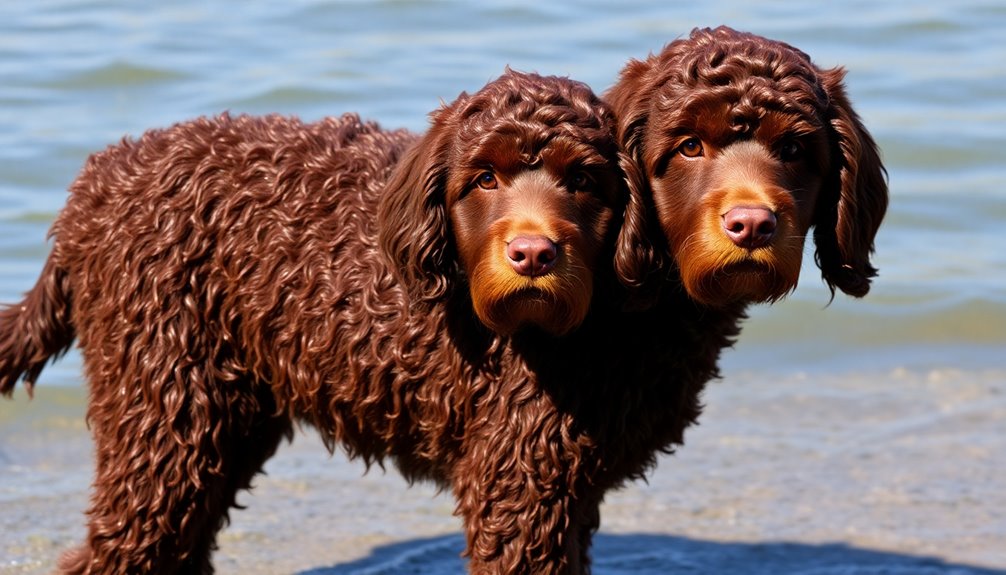
When you look at the Irish Water Spaniel, their shaggy coat isn't just for show—it's designed for their unique water retrieval skills. These dogs have been celebrated in 19th-century literature, showcasing their impressive abilities and distinctive appearance. Their thick, curly fur not only keeps them warm but also helps them thrive in wet environments. This breed is considered rare and vulnerable to extinction in Ireland, highlighting their unique status in the canine world.
Unique Water Retrieval Skills
Few breeds showcase such impressive water retrieval skills as the Irish Water Spaniel, thanks to its unique physical adaptations and innate abilities. With naturally webbed feet, this breed powers through water with remarkable agility, while its smooth "rat tail" allows for quick direction changes.
The thick, curly coat keeps the dog warm in cold water, ensuring it can handle rigorous swims without hesitation. Additionally, this breed's serious demeanor contributes to its effectiveness in the field, allowing it to remain focused during hunting tasks.
When it comes to retrieving, the Irish Water Spaniel excels at locating waterfowl from vast bodies of water or marshes. Their keen sense of smell and high trainability make them responsive to both verbal commands and hand signals.
You'll find that they combine independence and teamwork effectively during retrieval tasks, consistently bringing back game with style and enthusiasm.
This breed's sturdy, well-balanced build is ideal for both land and water activities. With a minimal shedding curly coat and small, almond-shaped eyes, the Irish Water Spaniel not only looks unique but is also designed for performance.
Their strong work ethic and prey drive ensure they cover the field efficiently, pushing up birds and demonstrating their remarkable hunting skills.
Featured in 19th-Century Literature
The distinctive "shaggy" appearance of the Irish Water Spaniel has captured the imagination of many, making it a notable figure in 19th-century literature. While you won't find extensive literature solely dedicated to this breed, early texts on water spaniels often mentioned its unique traits. The first known description of a water spaniel appeared in 1607, but it wasn't until the 1830s that the Irish Water Spaniel began to gain recognition.
Justin McCarthy played a crucial role in refining the breed in the 1850s, creating the first pure-type Irish Water Spaniel, known as "Boatswain." His efforts established a breed standard that became widely accepted, particularly after dog shows introduced specific classes for the Irish Water Spaniel by 1859. This breed's shaggy coat—characterized by long, loose curls, a smooth face, and a unique "rat tail"—set it apart from other breeds, like Poodles and Afghan Hounds.
Artistic depictions, including an 1841 painting, further showcased its distinctive look. As the breed gained popularity among Irish and English sportsmen, its appearance became a celebrated topic in various breed histories, emphasizing its unique features. Its versatility in hunting, particularly as a working gun dog, highlighted its role as a complete companion for various shooting activities.
Active Lifestyle Compatibility

If you're an active family, the Irish Water Spaniel could be the perfect match for you.
They thrive on daily exercise and love participating in fun activities like swimming and hiking.
Just be prepared for their grooming needs, as their unique coat requires regular maintenance to keep them looking their best.
Ideal for Active Families
For families who lead an active lifestyle, welcoming an Irish Water Spaniel can truly enhance your daily adventures. This breed thrives on vigorous exercise, needing at least 1 to 2 hours of physical activity each day.
Whether you enjoy brisk walks, jogging, or swimming, your Irish Water Spaniel will eagerly join in on the fun. They'll love hiking, cycling, and playing fetch, ensuring that your weekends are filled with excitement.
These dogs are perfect for families who can provide not just physical exercise, but also mental stimulation. Engaging in dog sports like agility and dock diving will challenge both their minds and bodies.
With their affectionate nature and eagerness to please, they quickly become loyal companions who fit right into your family dynamic.
While they thrive in spacious homes with fenced backyards, they can adapt well to apartment living if you provide regular access to dog parks.
Just be sure to offer varied activities to keep boredom at bay. If you're an active family looking for a dedicated and energetic partner, the Irish Water Spaniel might be the ideal addition to your household!
Grooming Needs and Maintenance
Regular grooming is essential for keeping your Irish Water Spaniel looking and feeling their best, especially when they're part of an active family.
Brush your dog's coat weekly to remove loose fur and dirt. A coarse brush and wide-tooth comb will help prevent matting and tangling, particularly in spots like behind the ears and under the legs. Additionally, the rugged build of the Irish Water Spaniel means their coat can withstand various outdoor activities, making grooming even more important.
Trim their coat every 2-3 months to maintain its shape and appearance, using scissors or a professional groomer if needed.
Ear care is crucial, too. Clean your dog's ears weekly with a veterinarian-approved cleaner, and dry them thoroughly after baths or swimming to prevent moisture buildup.
Regularly inspect for signs of infection, such as redness or odor.
Don't forget about nail and skin care. Trim their nails every 4-6 weeks to avoid overgrowth and bathe your dog monthly, using a mild dog shampoo.
After swimming or bathing, ensure you dry their skin and coat to prevent skin issues.
Additionally, brush their teeth daily and clean around the eyes to prevent irritation.
With proper grooming, your Irish Water Spaniel will stay healthy and ready for all your family adventures.
Frequently Asked Questions
How Do Irish Water Spaniels Interact With Other Pets?
When you introduce an Irish Water Spaniel to other pets, it's essential to do so carefully.
They can get along well if properly socialized, but watch for any hunting instincts, especially around smaller animals.
You'll want to supervise interactions to ensure harmony.
With consistent training and positive reinforcement, you can help them build relationships with other pets, making your home a more peaceful environment for everyone involved.
What Activities Are Best for Irish Water Spaniels?
To keep your Irish Water Spaniel happy and healthy, you should focus on both physical and mental activities.
Aim for at least 1 to 2 hours of exercise daily, including brisk walks, jogging, and swimming.
Incorporate obedience training and puzzle toys for mental stimulation.
Socialize your dog early to help it interact well with others.
Engaging in dog sports like agility and retrieving games will further satisfy its active nature.
Are Irish Water Spaniels Suitable for Families With Young Children?
Yes, Irish Water Spaniels can be great for families with young children. They're gentle and easygoing, making them good companions.
With proper training and socialization, they're patient and playful, enjoying family activities. However, you'll need to supervise playtime to prevent overwhelming interactions.
Teaching your kids to interact respectfully is important, especially during the dog's teething phase when they might nip.
Do Irish Water Spaniels Shed a Lot?
Irish Water Spaniels don't shed a lot compared to many other breeds.
Their curly, water-resistant coat is designed to be low-shedding, making them a good option for some allergy sufferers.
However, you'll need to groom them regularly to prevent matting and tangling.
Brushing their coat 2-3 times a week helps manage loose hair.
While they're not hypoallergenic, they come quite close, so you might find them suitable for your home.
What Grooming Tools Are Recommended for Irish Water Spaniels?
For grooming your dog, you'll want a few essential tools. A wide-tooth steel comb helps you go through the coat, while a pin brush removes loose hair.
Use a mat separator for tough tangles and straight trimming shears for shaping.
Don't forget a gentle dog shampoo for baths, along with a rough towel to dry them off.
Lastly, keep a nail trimmer handy for monthly maintenance to ensure their paws stay healthy.
Conclusion
In conclusion, the Irish Water Spaniel is an adaptable and lively breed perfect for active families or individuals who love the outdoors. Their unique appearance and playful nature make them delightful companions, while their intelligence ensures they thrive with proper training and socialization. If you're ready to embrace a water-loving friend who enjoys adventures and cuddles, the Irish Water Spaniel might just be the ideal addition to your home. So, get ready for a fun-filled journey together!

